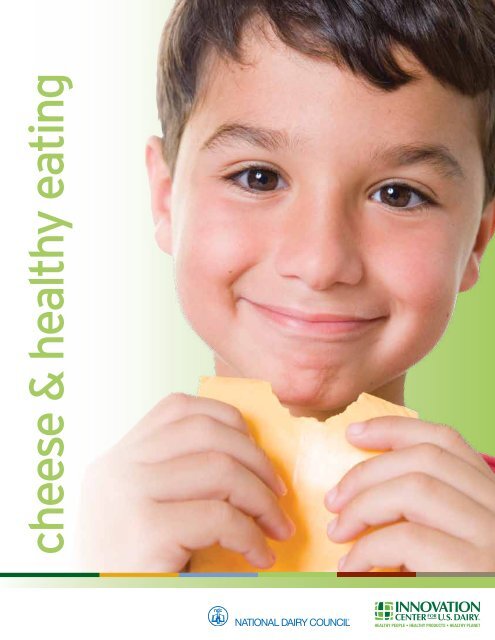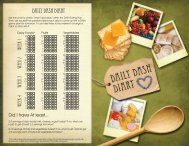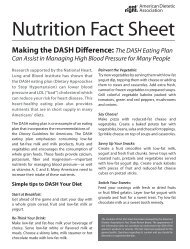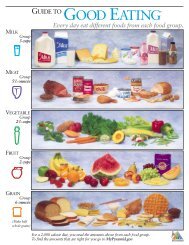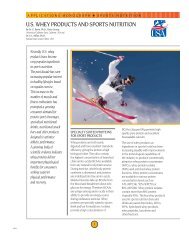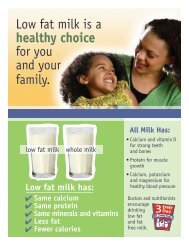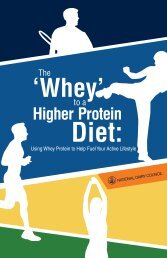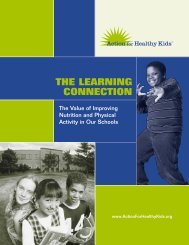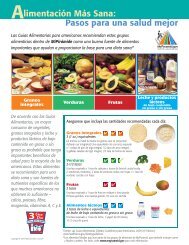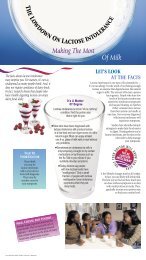cheese & healthy eating - National Dairy Council
cheese & healthy eating - National Dairy Council
cheese & healthy eating - National Dairy Council
Create successful ePaper yourself
Turn your PDF publications into a flip-book with our unique Google optimized e-Paper software.
<strong>cheese</strong> & <strong>healthy</strong> <strong>eating</strong>
Did you know?<br />
Cheese can fit into almost any <strong>eating</strong> plan. This brochure<br />
provides statistics, facts and nutrition information on<br />
<strong>cheese</strong> and how it can help meet health and wellness needs.<br />
Other countries have higher <strong>cheese</strong> consumption, yet lower incidence<br />
of hypertension and obesity.<br />
• Hypertension affects 16.5 percent of French adults compared with<br />
31.3 percent of U.S. adults. 1,2,3,4<br />
Cheese consumption<br />
per capita, in lbs.<br />
% of obese adults<br />
68<br />
18<br />
Greece<br />
57<br />
11<br />
France<br />
Sixteen percent of teenagers and 26 percent of<br />
adults are reducing or not <strong>eating</strong> meat in their<br />
diets and both are looking for additional sources<br />
of protein. 5<br />
• Cheese can help fill the protein gap. Cheese contributes<br />
high-quality protein as well as calcium, phosphorus and<br />
vitamin A to the American diet.<br />
• U.S. preteen and teenage girls 9 to 18 are at risk for<br />
not getting enough calcium according to the Institute<br />
of Medicine. 6<br />
• As part of a <strong>healthy</strong>, balanced diet, <strong>cheese</strong> can help fill<br />
this gap. Most <strong>cheese</strong>s are a good to excellent source<br />
of calcium.<br />
• Cheese may help children eat more fruits, vegetables<br />
and whole grains.<br />
• A recent study indicates that the visible addition of<br />
<strong>cheese</strong> to various middle school menu offerings may<br />
help increase the consumption of fruits, vegetables and<br />
whole grains compared with these items without <strong>cheese</strong>. 7<br />
Pairing foods with <strong>cheese</strong> potentially helps to increase<br />
total nutrient intake to improve diet quality.<br />
50<br />
16<br />
Germany<br />
33 34<br />
United<br />
States<br />
Fast facts<br />
• It takes 10 pounds of milk to make 1 pound of <strong>cheese</strong>.<br />
• The dairy food group is the top source of dietary calcium<br />
in the American diet. 8<br />
• Cheese is the No. 2 source of dietary calcium for<br />
Americans. 8<br />
• Cheese is more than just calcium; it also provides<br />
high-quality protein needed to help stay <strong>healthy</strong>.<br />
• For those with lactose intolerance, <strong>cheese</strong> can be an<br />
important source of calcium. Natural <strong>cheese</strong>s such as<br />
Cheddar, Colby, Monterey Jack, mozzarella and Swiss<br />
contain minimal amounts of lactose, because most of<br />
the lactose is removed when the curds are separated<br />
from the whey in the <strong>cheese</strong> making process.<br />
• Most dairy foods are gluten-free. Natural <strong>cheese</strong>s<br />
are gluten-free and in the case of <strong>cheese</strong>s that have<br />
added flavors or are processed, check the food label’s<br />
ingredient list to make sure ingredients sourced from<br />
wheat, barley or rye aren’t added.
Cheese<br />
… a few simple ingredients<br />
Cheese is a complex food made from a few simple<br />
ingredients. Cheese makers have developed thousands<br />
of varieties of <strong>cheese</strong> around the world, each with a unique<br />
taste, texture and nutritional profile. No <strong>cheese</strong> is the<br />
same — there are many standards of identity for <strong>cheese</strong>,<br />
because there are a number of ways to adjust the basic<br />
recipe to get a distinct product (e.g., Cheddar, Swiss, blue,<br />
Brie, mozzarella, etc.).<br />
Natural <strong>cheese</strong> is made from four basic ingredients:<br />
milk, salt, starter culture or “good bacteria” and an<br />
enzyme called rennet. The nutrients found in <strong>cheese</strong><br />
(e.g., calcium, protein, phosphorus) are there because milk<br />
is the main ingredient in <strong>cheese</strong>. 9 Salt is needed to finish<br />
the transformation of liquid milk into enjoyable <strong>cheese</strong>.<br />
Salt also acts as a natural preservative. 10<br />
Process <strong>cheese</strong> is made from high-quality natural <strong>cheese</strong><br />
so it also provides important nutrients such as calcium,<br />
phosphorus and protein. And it can be made to have<br />
more calcium as well as added vitamin D. Historically,<br />
process <strong>cheese</strong> was used to provide shelf-stable <strong>cheese</strong><br />
for wartime and for shipping to warmer climates. 11,12,13<br />
The processing halts the aging process so the <strong>cheese</strong><br />
maintains its flavor, texture and smoothness. Process <strong>cheese</strong><br />
is customizable for flavor and qualities such as a smooth<br />
melt that make it a versatile, tasty and easy-to-use food.<br />
The amount of salt used impacts firmness, flavor, food<br />
safety and preservation. 10<br />
Cheese has been around for centuries and is rich in culture<br />
• Its origins date back to ancient times when travelers<br />
from Asia are believed to have brought the art of <strong>cheese</strong><br />
making to Europe. According to an ancient legend,<br />
the first <strong>cheese</strong> was accidentally made by an Arabian<br />
merchant who carried his milk in a pouch made from an<br />
animal’s stomach. The rennet in the lining of the pouch<br />
combined with the heat of the sun and caused the milk<br />
to separate into curd and whey. That night he found<br />
that the whey satisfied his thirst, and the <strong>cheese</strong> (curd)<br />
satisfied his hunger. 14<br />
• Cheese making was common in the Roman Empire<br />
and the Romans passed on their knowledge to the rest<br />
of Europe. The art of <strong>cheese</strong> making flourished. The<br />
Pilgrims included <strong>cheese</strong> in the Mayflower’s supplies for<br />
their voyage to America in 1620. Once in the New World,<br />
the craft of <strong>cheese</strong> making spread quickly. 14<br />
• The <strong>cheese</strong> making process is an art with roots going<br />
back to Biblical times, and is a sustainable and natural<br />
food that helps keep cultures, communities and families<br />
vibrant and <strong>healthy</strong> today. 14
Cheese can fit into<br />
almost any <strong>eating</strong> plan<br />
Because there are so many different types of<br />
<strong>cheese</strong>, it’s a nutritious choice that easily fits<br />
into most <strong>eating</strong> plans — the Dietary Guidelines<br />
for Americans (DGA) general population<br />
recommendations and many of its meal plans; the<br />
Dietary Approaches to Stop Hypertension (DASH)<br />
diet, diabetic, Mediterranean, plant-based, vegetarian,<br />
gluten-free and low-lactose, among others.<br />
What about fat?<br />
Cheese accounts for only 9 percent of the total fat<br />
and 16 percent of the saturated fat in the U.S. diet. 15<br />
Emerging research has shown simply reducing<br />
saturated fat in the diet is not associated with a<br />
decreased risk of heart disease or cardiovascular<br />
disease. 16 And scientists from Harvard have<br />
identified a component in dairy fat that may reduce<br />
the risk of type 2 diabetes. 17<br />
What about sodium?<br />
Salt/sodium plays an important role in <strong>cheese</strong><br />
making. The majority of the sodium in the U.S. diet<br />
(92 percent) comes from sources other than <strong>cheese</strong><br />
(see chart below). 18 Cheese contributes only 8 percent<br />
of the sodium. 18 Salt is a vital part of the <strong>cheese</strong><br />
making process, as it controls moisture, texture,<br />
taste, functionality and food safety. So, salt cannot be<br />
completely eliminated; however, some <strong>cheese</strong>s require<br />
less than others.<br />
Sources of sodium in the<br />
diet by food groups 18<br />
Salt as Ingredient<br />
Other Foods<br />
Grain Products<br />
Meat, Fish, Poultry<br />
Cheese<br />
Vegetables<br />
<strong>Dairy</strong>, Other<br />
6.5%<br />
7.8%<br />
15.7%<br />
3.5%<br />
21.5%<br />
22.7%<br />
22.5%<br />
More than 300 different <strong>cheese</strong>s in the U.S. and 2,000 19 in the<br />
world can be classified into eight categories: 20<br />
Blue<br />
Hard<br />
Pasta Filata<br />
Processed<br />
Semi-hard<br />
Semi-soft<br />
Soft and Fresh<br />
Soft-ripened<br />
A characteristic of varieties that develop blue or<br />
green streaks of harmless, flavor-producing mold<br />
throughout the interior. Generally, veining gives<br />
<strong>cheese</strong> an assertive and piquant flavor. Examples:<br />
Roquefort, Gorgonzola and Danish blue.<br />
Well-aged, easily grated and primarily used in<br />
cooking. Examples: Parmesan, Romano and Asiago.<br />
Curds are heated and stretched or kneaded before<br />
being molded into shape. Stretches when melted.<br />
Examples: mozzarella, string and provolone.<br />
A blend of fresh and aged natural <strong>cheese</strong>s that<br />
have been shredded, mixed and heated with an<br />
addition of an emulsifier salt, after which no<br />
further ripening occurs. Examples: American<br />
<strong>cheese</strong> and process <strong>cheese</strong> spreads.<br />
A classification of <strong>cheese</strong> based upon texture.<br />
Examples: Colby, Cheddar, Edam and Gouda.<br />
A wide variety of <strong>cheese</strong>s made with whole milk<br />
that melt well when cooked. Examples: Monterey<br />
Jack, brick, Fontina, Havarti and Muenster.<br />
Have high moisture content, typically made with<br />
the addition of lactic acid cultures. Examples:<br />
cottage <strong>cheese</strong>, cream <strong>cheese</strong>, Feta, Mascarpone,<br />
ricotta and queso blanco.<br />
Classification of <strong>cheese</strong> based upon texture.<br />
Examples: Brie and Camembert.
What’s your type? 21<br />
Looking to lower the sodium in your diet?<br />
Try: Swiss, Monterey Jack, ricotta, Port de Salut or<br />
Parmesan (1 Tbsp). Also try lower sodium varieties of<br />
Colby-Jack, provolone, Muenster, mozzarella or Cheddar.<br />
Watching the fat in your diet?<br />
Try: Parmesan, Romano (grated) or part-skim mozzarella.<br />
Also try lower fat options of cottage, ricotta, Cheddar,<br />
Swiss, Parmesan, Colby, Muenster, provolone, Mexican<br />
blend* or American (process).<br />
Need more calcium in your diet?<br />
Try: Swiss, Cheddar, ricotta, mozzarella, Monterey Jack,<br />
Gouda, queso blanco, Mexican blend* or Colby.<br />
Looking for more protein options for your diet?<br />
Try: Swiss, cottage, ricotta, mozzarella, Monterey Jack,<br />
Cheddar, Gouda, Colby, Port de Salut, provolone,<br />
Mexican blend* or Muenster.<br />
Per 1 oz. (unless noted)<br />
Calories<br />
Protein<br />
Calcium<br />
Phosphorus<br />
Fat<br />
Sodium<br />
Lactose<br />
106<br />
8 g<br />
224 mg<br />
161 mg<br />
8 g<br />
54 mg<br />
0.02 g<br />
171<br />
14 g<br />
337 mg<br />
227 mg<br />
10 g<br />
155 mg<br />
0.38 g<br />
Watching lactose in your diet?<br />
Try: Cheddar, Swiss, Monterey Jack or mozzarella.<br />
*A blend of <strong>cheese</strong>s<br />
Swiss Monterey<br />
Jack<br />
Ricotta, Cheddar<br />
104<br />
7 g<br />
209 mg<br />
124 mg<br />
8 g<br />
150 mg<br />
0.14 g<br />
part-skim<br />
( 1 /2 cup)<br />
Did you know?<br />
If you are looking to lower the sodium in<br />
your diet, one tip is to choose a <strong>cheese</strong><br />
based on firmness and age. In general,<br />
softer, less-aged <strong>cheese</strong>s require less salt<br />
than harder, aged varieties. Lower-sodium<br />
and lower-fat <strong>cheese</strong>s also are available.<br />
Get more help on a <strong>cheese</strong> to meet your<br />
individual needs in the chart below. 21<br />
114<br />
7 g<br />
204 mg<br />
145 mg<br />
9 g<br />
176 mg<br />
0.07 g<br />
Mozzarella,<br />
part-skim<br />
72<br />
7 g<br />
222 mg<br />
131 mg<br />
4.5 g<br />
175 mg<br />
0.32 g<br />
Brie Process<br />
American<br />
(1 slice/21 g)<br />
95<br />
6 g<br />
52 mg<br />
53 mg<br />
8 g<br />
178 mg<br />
0.13 g<br />
79<br />
5 g<br />
116 mg<br />
108 mg<br />
7 g<br />
263 mg<br />
0.11 g<br />
Blue<br />
100<br />
6 g<br />
150 mg<br />
110 mg<br />
8 g<br />
395 mg<br />
0.14 g
Cheese and its nutrients offer<br />
health benefits<br />
Cheese can help fill<br />
nutrient gaps<br />
• Cheese can provide calcium for people who<br />
don’t meet daily recommendations and risk<br />
poor bone health.<br />
• Cheese also provides protein, phosphorus,<br />
vitamin A and zinc to the U.S. diet. 15<br />
• Cheese not only tastes great, it’s a<br />
convenient, portable and versatile food.<br />
When paired with fruits, vegetables and<br />
whole grains, it may help people eat<br />
more of these recommended food groups,<br />
including dairy.<br />
Cheese provides only 5% of the<br />
calories in the U.S. diet, but also: 15<br />
Calcium 21%<br />
Phosphorus 11%<br />
Protein 9%<br />
Vitamin A 9%<br />
Zinc 8%<br />
What is a serving<br />
size of <strong>cheese</strong>? 23<br />
• 1 1 /2 ounces of natural <strong>cheese</strong><br />
or 2 ounces of process <strong>cheese</strong>.<br />
• About four dice-size cubes is a<br />
visual reminder of a serving<br />
of <strong>cheese</strong>.<br />
Nutrient provided<br />
by <strong>cheese</strong>: Nutrient’s role in the body:<br />
Calcium Helps build and maintain strong bones and teeth;<br />
also important for nerves, muscle contraction and<br />
blood clotting.<br />
Phosphorus Helps strengthen bones and generate energy in<br />
the body’s cells.<br />
Protein Builds and repairs tissues in the body while helping<br />
to balance fluids, transport nutrients and aid in<br />
muscle contraction.<br />
Vitamin A Helps maintain normal vision, skin and immune<br />
system; also important for bone growth.<br />
Zinc Supports the immune system, wound healing and<br />
ability to smell and taste.<br />
Choose calories by the company they keep<br />
Natural <strong>cheese</strong> is made with four simple ingredients, and process <strong>cheese</strong> is<br />
made from natural <strong>cheese</strong>. Cheese is a high-quality food rich in nutrients that<br />
has been, and continues to be, part of a <strong>healthy</strong> <strong>eating</strong> plan. Many <strong>cheese</strong>s<br />
are excellent sources of calcium and good sources of high-quality protein and<br />
phosphorus — providing three nutrients particularly important for helping to<br />
build and maintain <strong>healthy</strong> bones. 21,22 Some natural and process <strong>cheese</strong>s are<br />
fortified with vitamin D.<br />
While nutrient profiles vary due to the large variety of <strong>cheese</strong>s, <strong>cheese</strong><br />
contributes essential nutrients for good health to the U.S. diet, including<br />
calcium, phosphorus, protein, vitamin A and zinc. See chart to the left.<br />
<strong>Dairy</strong> industry working voluntarily<br />
to address sodium in <strong>cheese</strong><br />
Despite the fact that <strong>cheese</strong> contributes only 8 percent<br />
of the sodium to the U.S. diet, <strong>cheese</strong> makers are<br />
working together to proactively address public health<br />
as well as meet people’s needs and lifestyles. Cheese<br />
makers continue to lead process control and product<br />
innovations as part of the solution to help lower<br />
sodium — all while maintaining strict expectations<br />
for food safety and taste.
References<br />
1 International <strong>Dairy</strong> Federation. Bulletin of the International <strong>Dairy</strong> Federation 446/2010: The World <strong>Dairy</strong> Situation 2010.<br />
2 Tibi-Levy Y, de Pouvourville G, Westerloppe J, Bamberger M. The cost of tr<strong>eating</strong> high blood pressure in general practice in France. Eur J Health Econ. 2008;9(3):229-236.<br />
3 Centers for Disease Control and Prevention. High Blood Pressure Frequently Asked Questions. Available at: http://www.cdc.gov/bloodpressure/faqs.htm. Accessed November 18, 2010.<br />
4 Organisation for Economic Co-operation and Development (OECD). Available at: http://www.oecd.org/document/35/0,3343,en_21571361_44315115_46064099_1_1_1_1,00.html.<br />
Accessed March 8, 2011.<br />
5 DMI Emerging Diets Research, 2010. Available at: http://www.usdairy.com/Health/ConsumerTrendsProteinLocal/Pages/Market%20Insights.aspx.<br />
6 IOM (Institute of Medicine). Dietary Reference Intakes for Calcium and Vitamin D. Washington, D.C.: The <strong>National</strong> Academies Press; 2011:480.<br />
7 Donnelly JE, Sullivan DK, Smith BK, et al. The Effects of Visible Cheese on the Selection and Consumption of Food Groups to Encourage in Middle School Students.<br />
J Child Nutr Manag. 2010;34(1). Available at: http://schoolnutrition.org/Content.aspx?id=14040.<br />
8 Fulgoni III VL, Keast DR, Quann EE, Auestad N. Food sources of calcium, phosphorus, vitamin D, and potassium in the U.S. Presented at Experimental Biology, Anaheim, Calif.<br />
April 24-29, 2010.<br />
9 Cheesemaking: A Wisconsin Tradition. Available at: http://trade.eatwisconsin<strong>cheese</strong>.com/wisconsin/how_<strong>cheese</strong>_is_made.aspx. Accessed February 15, 2011.<br />
10 Guinee TP. Salting and the role of salt in <strong>cheese</strong>. International Journal of <strong>Dairy</strong> Technology. 2004;57(2-3):99-109.<br />
11 Ustunol Z. Processed Cheese: What is that stuff anyway? Michigan <strong>Dairy</strong> Review. 2009. Available at: https://www.msu.edu/~mdr/vol14no2/ustunol.html. Accessed February 6, 2011.<br />
12 What’s That Stuff? Chemical & Engineering News. 2000;78(6):51. Available at: http://pubs.acs.org/cen/whatstuff/stuff/7806sci2.html. Accessed February 16, 2011.<br />
13 Kraft Foods. Kraft History: JL Kraft. Kraft.com. Available at: http://www.kraft.com.au/products/krafthistory/fredwalkerfounder/jlkraft.aspx. Accessed May 16, 2011.<br />
14 International <strong>Dairy</strong> Foods Association. Available at: http://www.idfa.org/resource-center/industry-facts/<strong>cheese</strong>/. Accessed February 16, 2011.<br />
15 <strong>Dairy</strong> Research Institute, NHANES (2003-2006). Ages 2+ years. Data Source: Centers for Disease Control and Prevention, <strong>National</strong> Center for Health Statistics, <strong>National</strong> Health<br />
and Nutrition Examination Survey. Hyattsville, Md.: U.S. Department of Health and Human Services, Centers for Disease Control and Prevention. 2003-2004; 2005-2006. Available<br />
at: http://www.cdc.gov/nchs/nhanes.htm.<br />
16 Siri-Tarino PW, Sun Q, Hu FB, Krauss RM. Meta-analysis of prospective cohort studies evaluating the association of saturated fat with cardiovascular disease. Am J Clin Nutr.<br />
2010;91(3):535-546.<br />
17 Mozaffarian D, Cao H, King IB, et al. Trans-Palmitoleic Acid, Metabolic Risk Factors, and New-Onset Diabetes in U.S. Adults: A Cohort Study. Ann Intern Med. 2010;153(12):790-799.<br />
18 Hentges E. Sources of Sodium in the Food Supply. Paper presented at: Institute of Medicine Committee on Strategies to Reduce Sodium Intake, Information-Gathering Workshop;<br />
2009; Washington, D.C.<br />
19 International <strong>Dairy</strong> Foods Association. Available at: http://www.idfa.org/news--views/media-kits/<strong>cheese</strong>/<strong>cheese</strong>-facts/. Accessed February 16, 2011.<br />
20 Wisconsin Milk Marketing Board. Available at: http://www.eatwisconsin<strong>cheese</strong>.com/<strong>cheese</strong>/<strong>cheese</strong>cyclopedia.aspx. Accessed March 10, 2011.<br />
21 U.S. Department of Agriculture, Agricultural Research Service. 2010. USDA <strong>National</strong> Nutrient Database for Standard Reference,<br />
Release 23. Nutrient Data Laboratory Home Page. Available at: http://www.ars.usda.gov/ba/bhnrc/ndl. Accessed March 9, 2011.<br />
22 U.S. Department of Health and Human Services. Bone Health and Osteoporosis: A Report of the Surgeon General.<br />
Rockville, Md.: U.S. Department of Health and Human Services, Office of the Surgeon General, 2004.<br />
23 U.S. Department of Health and Human Services and U.S. Department of Agriculture. Dietary Guidelines for<br />
Americans, 2010. 7th Edition, Washington, D.C.: U.S. Government Printing Office, January 2011.<br />
Education is the true link<br />
between diet and health<br />
Speak with your health care provider for information<br />
specific to your needs.<br />
©2011 Innovation Center for U.S. <strong>Dairy</strong> ® and <strong>National</strong> <strong>Dairy</strong> <strong>Council</strong> ®


